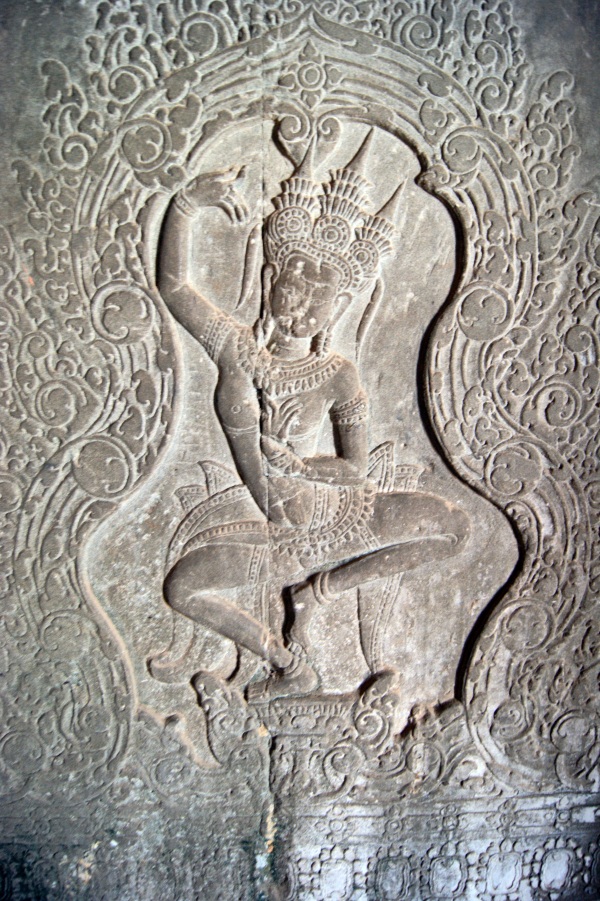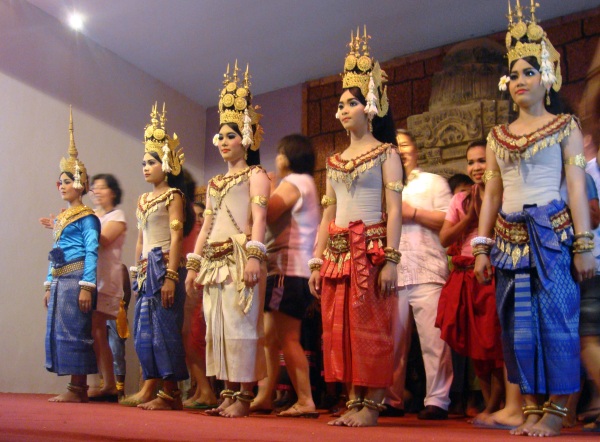Many religions have within them the idea of ethereal beings of great beauty inhabiting the heavens. The three religions of The Book share the notion of Angels; the old Norse gods had their Valkyries; the ancient Greeks had the Muses; and south-east Asian Hindus have Apsaras, the celestial maidens who dance magnificently to the music of the heavens and sometimes seduce both gods and men. When the main religion in the Malay-Indonesian peninsular changed, formerly Hindu apsaras were co-opted into Islam, so that they are now seen as the heavenly maidens described in the Q’uran, given as a post-mortem reward to devout Muslim males.
On the walls of Angkor Wat, the enormous temple complex in Cambodia, there are 1,796 bas-relief carvings of Apsaras and Devatas, the celestial maidens of the Hindu religion, all of them unique and different. Many of the smaller figures show the maidens dancing, in which case, they are known as Apsaras. Most of the larger figures, up to life-size sometimes, are shown standing, either in preparation for the dance, or as sentinels, in which case they are Devatas.
Almost every surface of every wall at Angkor is elaborately carved into relief decoration of great complexity, with many representations of gods, kings, battles, and historical and religious narratives, as well as many celestial maidens. This devata is surrounded by a typical example of purely decorative relief work.

The stylised four-petal lotus flower design is one of the most common repeating motifs in all south east Asian art, Buddhist and Hindu.
This double pair of devatas have elaborate hair styles rather than ceremonial gilded head-dresses, which are more typical. The formal way the lower body garment was folded and secured changed over time. A documented chronology of these changing apsara fashions is one way that helps archaeologists to date the construction of a temple, or at least, put a date on when the sculptures were carved.

These devatas have very elaborate hairstyles rather than formal head-dresses. The one on the right is holding up a lotus bud, the model for the shape of the stone towers of Angkor Wat.

During the period when these figures were carved, the conventional way of showing the feet was always pointing sideways, as they were in ancient Egyptian art, but here they are seen from above not side-on.
This devata is wearing the more typical ornate headdress with its three golden spires. On her upper body she is wearing an elaborate collar piece and upper arm bracelets, a gold belt-chain around her neck that crosses over to go round her waist, and nothing else. Celestial maidens are usually depicted bare-breasted.

This image has worn well, and still shows the intricate gilded decoration of the head-dress and body jewellery traditionally worn by apsara dancers
This is a typical apsara dancing pose. Traditional Khmer Apsara dance as it is performed today is quite slow, very balletic, and very controlled, with the dancers’ open hands and fingers curving backwards at what appears to be an impossible angle. I spoke with a young woman who had trained throughout her youth to be a dancer, but she could no longer perform since her dancing instructor broke two of her fingers in the continual process of training them to bend further and further backwards. One of these fingers had healed at an unattractively crooked angle, which ended her potential career as a professional Apsara dancer.

In this carving of an apsara dancing, you can see the last three fingers of each hand bending back in a steep curve, a position that takes a long time to develop in trainee dancers.
And here is a modern group of traditional Khmer ‘Apsara Dancers’ posing with tourists at the end of their performance in modern Angkor. The costumes they wear are quite faithful facsimiles of the originals as depicted on the walls of the many hundreds of ancient temples nearby, except that, to avoid offending foreign tourists, the dancers no longer perform topless.


Lois
/ June 30, 2013Most interesting; Fascinating comparison between the different styles of hair, headgear, skirts etc.
Peter Bull
/ July 1, 2013One of the interesting things is that even though there are sooo many of them, they weren’t carved from any kind of template. Every one of them is uniquely drawn and realised, not just in some of the details, but in their different faces and expressions. The artists didn’t see them as duplicates, but treated each one as an individual. Not mass-produced, just produced en masse.